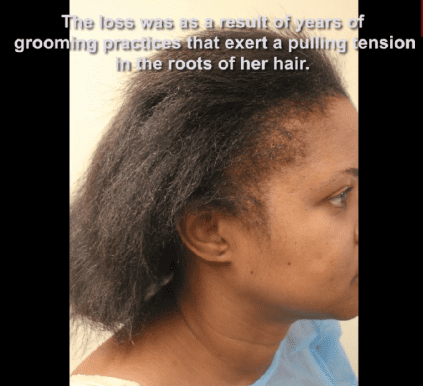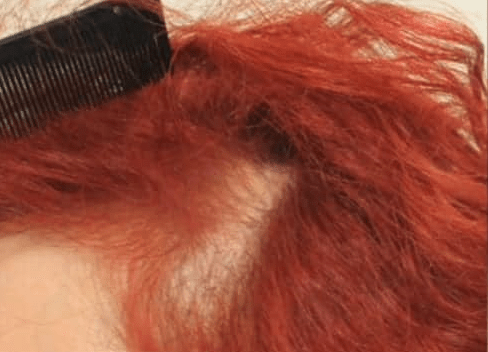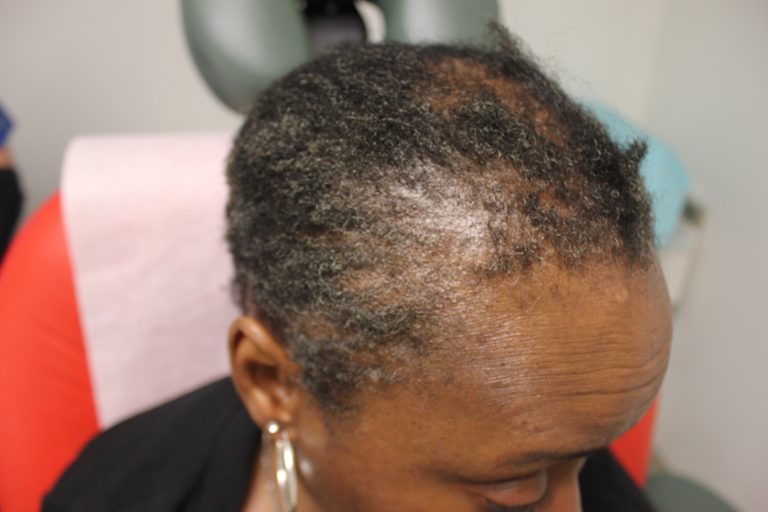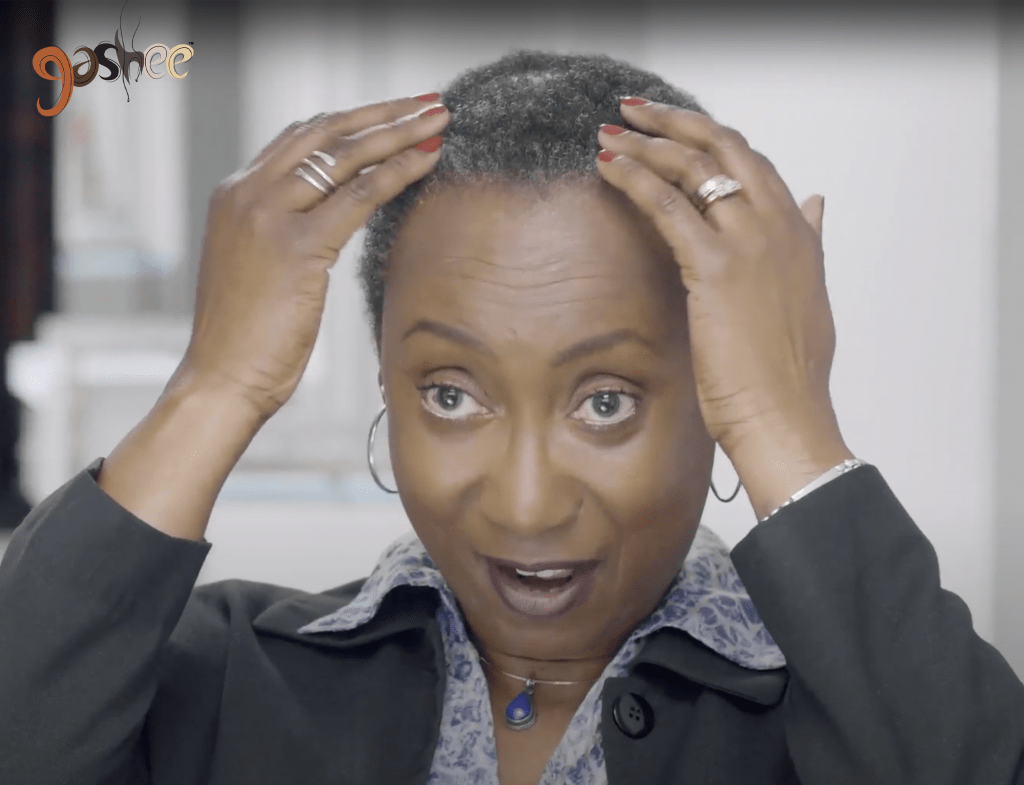Published on February 12, 2021. Last Updated on February 12, 2021.
Traction alopecia is a gradual type of hair loss caused by hairstyling beauty practices which lead to the constant pull of hair at the roots. In many cases, it results in bald, empty-looking edges, the marginal regions at the hairline, temples, and sides of the head. These clinical markers are referred to as “fringe signs”
Alternatively, traction alopecia may also manifest as non-marginal alopecia where hair loss occurs in patches. Either way, sufferers are left feeling devastated about their appearance. With the ongoing perception of themselves as being unattractive, they often lose their enthusiasm for many of the things in life that they once loved.
As a brand, Dr.UGro Gashee is aware of the devastating emotional consequences resulting from hair loss conditions like traction alopecia. We have formulated our products using dermatological expertise so that our products will be in a better position of producing long-term results that people will be happy with so that they can then get their groove back.
Traction Alopecia Edge Loss Can Affect All Ethnicities

Traction alopecia is often associated with women of African descent due to the modern cultural use of tightly pulling hair-styling practices such as:
- Box braids
- Weaves
- Extensions
- Lace-front wigs
- Cornrows
- Ponytails
- Deadlocks
It has been estimated that traction alopecia affects about a third of black women who regularly wear their hair in traumatic, tightly pulling hairstyles on an ongoing basis.
However, in reality, both men and women of all ethnic groups are prone to developing traction alopecia if they choose to adopt high-risk hair pulling practices for their day-to-day look.
In other words, TA can also affect:
- Caucasians
- Asians
- Hispanics
- Middle Easterns
- Etc.

Tension based hair loss has also been affecting a greater number of celebrities, largely due to their reliance on hair extensions and tight, sleek ponytails. Rumored examples include:
- Naomi Campbell
- Kim Kardashian
- Arianna Grande
No one is more prone to developing this condition due to genetic or physiological traits. Traction alopecia is thus regarded as a hair loss disorder that is 100% contingent on lifestyle practices.
Is Traction Alopecia Reversible
It is possible for sufferers of traction alopecia to reverse their condition if their hair follicles are still capable of producing new hair growth. Constant tension (due to hair pulling) inflicts mechanical damage to the hair follicle. This then triggers the body’s inflammatory processes.
The early stages of TA are often marked by small raised bumps on the scalp. Also, a greater proportion of hair follicles transition from their active anagen growth stages to enter a transitional period known as catagen before finally graduating into a resting, non-growth phase known as telogen.
Early to mid-stages of traction alopecia are reversible through early detection, the use of effective topical treatment, and the adoption of safe, relaxed hairstyles.
On the other hand, if the condition is allowed to progress to more severe stages, permanent scarring fibrosis then gradually replaces the hair follicles themselves. At this point, no new hair can be produced.
The Natural Power of Plants Offers New Hope For Qualified Traction Alopecia Cases
Again, the key to reversing traction alopecia is early intervention when the hair follicles have not yet lost their capacity to construct new hair shafts.
During these earlier stages, it is possible to subdue inflammatory processes and heal mechanical damage inflicted on the hair follicles.
Research is now finding that various plant types wield the capacity to treat inflammation, improve circulation, ward off age-promoting oxidative stress, and even boost the overall health of the hair follicles, helping more of the return to the active anagen growth phases.
However, the potential of these healing capabilities can only be realized through specialized processes that preserve the integrity of the bioactive properties held within the original plant, as intended by nature.
Using the right methods and techniques to improve these aims, it is then possible to harness the potential of plants to improve the well-being and vitality of the hair follicles themselves, and even reverse early to mid-stage manifestations of traction alopecia.
By incorporating this knowledge into all-natural product formulations dedicated to hair and follicular health, Dr.UGro Gashee is poised to help qualified female and male TA sufferers get a second chance at achieving more youthful forms of hair growth.
Edge loss due to traction alopecia can be scary, but not necessarily hopeless. Here’s proof.

Diane suffered from a combination of traction alopecia and CCCA (Central Cicatricial Centrifugal Alopecia) She lost hair on both her edges and other regions of her scalp.
Although Diane’s condition was past the earliest initial stages of traction alopecia hair loss, she was still able to recover normal and impressive looking coverage after using our line of products.
Diane’s amazing success story goes to show that it is certainly possible to reverse traction alopecia hair loss using the therapeutic healing potential of plant-based medicine.

The experience of seeing renewed hair growth is healing and uplifting to a person’s soul and spirit.
Helping people get their edge back and achieve new milestones is something that gives us joy and fulfillment as hair scientists. We realize that it is a natural human desire to see one’s self as attractive and beautiful. It cannot be argued that our hair plays a huge role in how we construe our self-image when we see ourselves in the mirror.
If you feel inspired by Diane’s story and would like to learn about other Gashee True Life stories, click here to learn more.
Nature Is Designed To Heal
Our own experience-based journey to harness the incredible healing potential of plants has culminated in a burgeoning roster of real-life success stories.
These tangible changes in people’s lives confirm our belief that we, as humans, are already synergistically connected to nature which is already designed with the capability to heal and treat different areas of our health. All we have to do is to stop, observe and seek out these answers.
Frequently Asked Questions on Getting Your Edge Back
What happens if I cannot cure or reverse my traction alopecia hair loss.
If your hair follicles are incapable of producing new forms of growth, another option to consider would be hair transplantation. With this procedure, healthy follicles are harvested and then implanted into the regions affected by hair loss. In order to qualify as a patient, you would need to have sufficient quantities of these follicles to produce significant and lasting coverage improvements.
Why does TA commonly affect the edges of the scalp
The answer to this question is not entirely clear. However, based on this type of manifestation, it can be logical to assume that the hair follicles within the marginal regions of the scalp may be built as weaker structures that are more vulnerable to tears and other forms of damage caused by tension and weight.
If I have afro-textured hair and want to go natural, what are some things I would need to know?
Going natural means that you will have to live with two different types of hair textures (i.e. straight and curly). Curling the straight ends of your hair as well as the curly sections can achieve a more uniform look. However, it may be best to choose a hairstylist who has experience helping their clients look their best during the process of transitioning. You will also have to take measures to keep your hair well-moisturized and detangled for better manageability.
Further Reading
